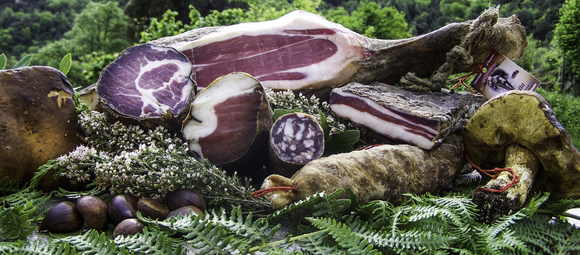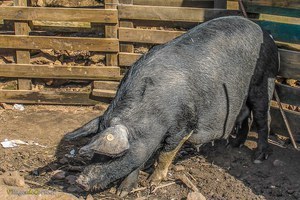- Activities
- Gastronomy
- Corsican charcuterie
- List of charcuterie
Corsican charcuterie
Corsican charcuterie must-haves

An overview of the main Corsican charcuterie products, available from producers wherever they are. Sausage, coppa, lonzu and prisuttu are just some of the meats served on tasting platters. And don't forget the famous figatellu, which is eaten after it has been cooked.
These charcuterie products are smoked and matured in specialized cellars or rooms, keeping them cool and ventilated.
Corsican sausage - Salsiccia
Corsican sausage - A Salciccia - is made from the best parts of the pig, and its more affordable price makes it the best-selling flagship of Corsican charcuterie.
Corsican Coppa - PDO registered
Coppa - coppe in the plural - is made from the neck muscles of the pig. It's a peppery delicatessen with a distinctive, highly appreciated taste, different from sausage, and is one of the most popular cured meats. Corsican coppa was granted AOC status in 2012.
Lonzu - PDO registered
Lonzu - plural lonzi - is the equivalent of the tenderloin, the muscle in the lower part of the pig's back. It's a delicatessen found only in Corsica.
Lonzu has had an AOC label since 2012.
Figatellu
Figatellu - figatelli in the plural - is a bit like the star of the charcuterie world, produced from December onwards during the winter months. Unlike other charcuterie, figatellu is eaten cooked, ideally grilled over a wood fire.
Prisuttu - cured ham - PDO registered
Prisuttu is a Corsican cured ham from the pig's thigh. It is salted, dried and matured for over a year before being prepared. It is sold whole, in pieces or sliced. Since 2012, prisuttu has had AOC certification.
Panzetta
Panzetta is a charcuterie made from pork belly, as the name suggests. It has a streaky appearance, with fat and lean pork intertwined. It can be eaten raw, but is also used in cooking to add flavor to a dish, playing the same role as lardons, but with a more pronounced taste.
Other cured meats
In addition to the charcuterie mentioned above, other lesser-known preparations deserve our attention. Starting with head cheese, which has nothing to do with cheese, but uses various parts of the pig's head: cheeks, tongue, snout. These parts are cooked in a preparation that produces a result somewhere between jelly and pâté. You can also add pork pâté, boudin or belly pork, depending on the producer.
All charcuterie (except canned) should be kept at the bottom of the fridge. Consume in moderation!



